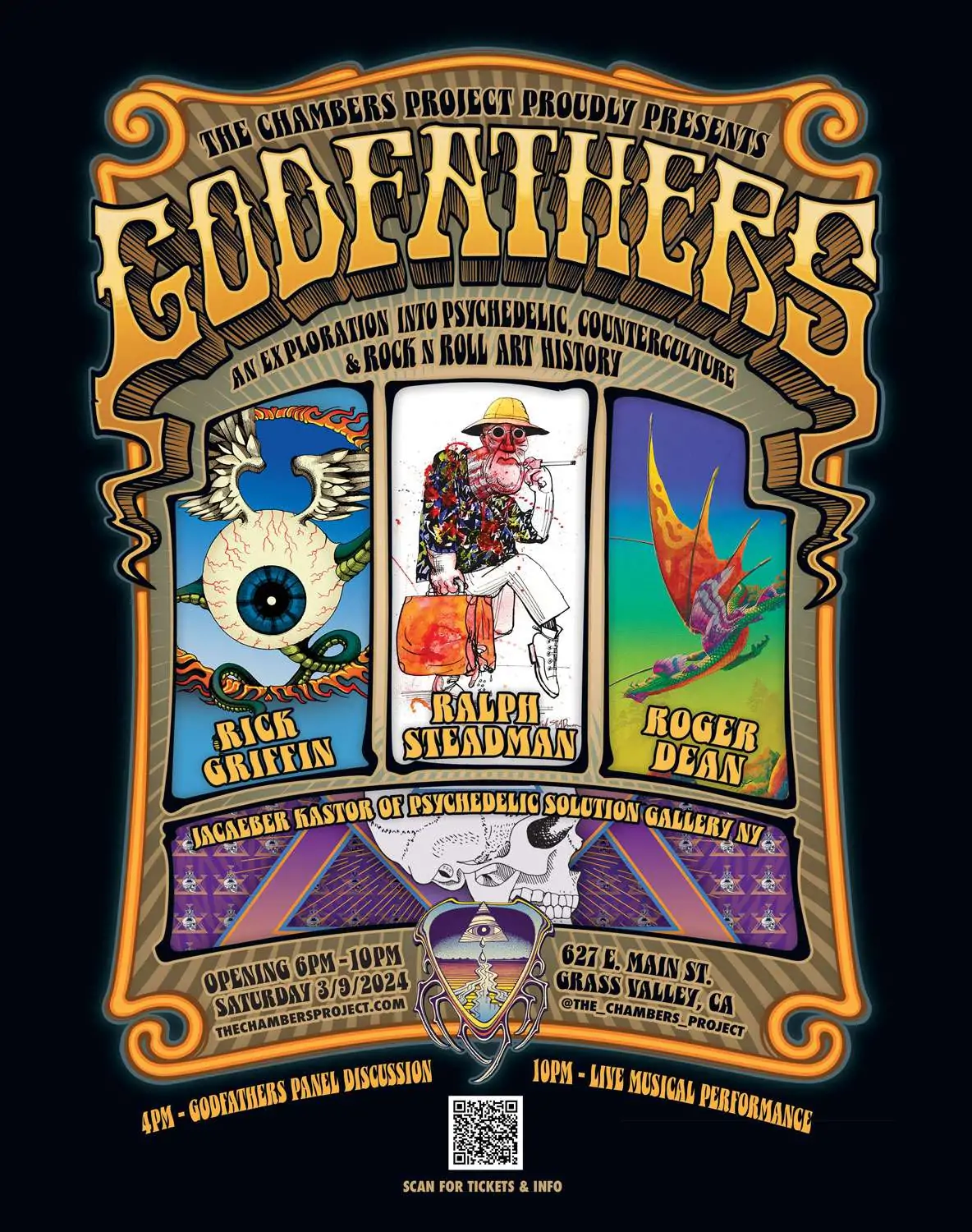Rick Griffin, Ralph Steadman,
Roger Dean & Jacaeber Kastor
“GODFATHERS”
March 09, 2024

Grass Valley, CA 95945
The Chambers Project Announces The Opening of the “GODFATHERS” Exhibition Featuring the work of Rick Griffin, Ralph Steadman, Roger Dean & Jacaeber Kastor.
GRASS VALLEY, CA
The Chambers Project has announced an important and historic exhibit of paintings and drawings from the flowering era of psychedelic and visionary art. The exhibit is timely, as a resurgence of public interest in psychedelic art has followed recent news about the legalization of psilocybin and cannabis in many US cities.
Many writers have described the social circumstances of psychedelic art, especially its coalescence in San Francisco during the second half of the decade, but few have treated it with the respect and care of an art historian. Brian Chambers’ curation of this exquisite exhibit challenges the art world to treat the neglected paintings and prints of the period with the respect they deserve – the 1960s and 1970s represent a unique moment in the cultural history of the West, when the subcultural forces of utopian idealism met with a new kind of imagery witnessed by intrepid explorers of the psychedelic world – its art was a direct response to the forces shaping the era. Chambers has a unique eye for cultural iconography.

The centerpieces of Godfathers are paintings and drawings by three master artists of the era – historically important and iconic imagery by Roger Dean, Ralph Steadman, and Rick Griffin. Dean is a living legend of visionary art. His art has consistently explored floating themes of freedom from the heavy weight of ordinary experience, imagining new, evolving worlds, and a cross-cultural mingling of Eastern and Western aesthetics. His paintings have been reproduced in more than a hundred million prints. Chambers has acquired Dean’s most important works for the exhibit, showing the iconic Relayer, a beautiful image of horsemen riding through a gracefully sculpted desert canyon of fanned stone rising impossibly over a scene of two desert vipers, ready to strike. The painting was licensed by the band Yes for their classic album. Dean’s association with the band continued for over fifty years, and their use of his art introduced him to millions of devoted fans. Dean’s beautiful The Quest recently sold for $500,000.
Only the punkish British artist Ralph Steadman could equal the deranged writing of Hunter Thompson. Steadman was the visual sidekick companion to Thompson when the famed gonzo journalist wrote his insanely drug-infested novel, Fear and Loathing in Las Vegas. While Thompson cranked out smashed sheets of staccato typing, Steadman drew the iconic images which illustrated the deranged story, and they were eternally tied to it when the book became a masterpiece of American literature. Steadman is the splattered master of fast and dirty drawings of the subterranean life that thrives beneath the surface of respectable society. He says he paints the ‘underfilth.’ For the exhibit, Chambers has secured Steadman’s historic original inks for Fear and Loathing in Las Vegas, which were first printed in Rolling Stone magazine, together with the famous Rolling Stone cover portrait of President Nixon and other drawings from Fear and Loathing on the Campaign Trail.
The great Rick Griffin is another of the iconic artists of the era in the show. Chambers has included the original artwork created for the excruciatingly rare poster known as The Hawaiian Aoxomoxoa, designed by Griffin to advertise a canceled concert by The Grateful Dead. The poster has a legendary status among the rock poster collecting community, for it is as elusive and rare as a white buffalo, and the original art is an artifact of extraordinary significance and value. Chambers is also showing the drawings Griffin created for his extravagant Man From Utopia comic, three of his large circus-themed Without a Net oil paintings which were used for the Grateful Dead’s album of live music from 1989-1990, and both Dylan and the Dead album covers
Giving the exhibit some streetwise context, Chambers is hanging the unique neon sign designed by artist Peter Max which once advertised Jacaeber Kastor’s Psychedelic Solutions storefront gallery in New York City. (The store’s sticker-plastered doors are in the collection of the Rock & Roll Hall of Fame, Cleveland.) Kastor organized exhibits of psychedelic art throughout the end of the 20thcentury, and recognized the cultural significance of printed LSD blotter sheets as vanishing useful art. Decorated with spectacular designs, the sheets were soaked in liquid LSD for distribution, and because they were consumed by users, the original designs are rare artifacts of the visual history of the acid underground. Several examples of the blotters are in the exhibit – they have survived because they were never doused in the drug. These are signed by heroic giants of the American psychedelic movement like Ken Kesey, Timothy Leary and Albert Hoffman.
Because New York’s art hegemony concentrated upon the work of a limo-elite avant-garde and contemptuously condemned popular art, psychedelic and visionary art remained outside the domain of serious examination. Now, the bubble-bath of postmodernity favors popular art and emergent art forms rise from the chaos of contemporary culture. As living memory becomes history, The Chambers Project exhibit Godfathers is an important step on the road to saving the treasures and stories of an extraordinary era, gathering many of the most important milestones of this essential stream of Western art.

Rick Griffin
Merchandise
Ralph Steadman
Merchandise
Roger Dean
Merchandise
Jacaeber Kastor
Merchandise

Rick Griffin
ARTIST BIO

Ralph Steadman
ARTIST BIO

Roger Dean
ARTIST BIO

Jacaeber Kastor
ARTIST BIO
